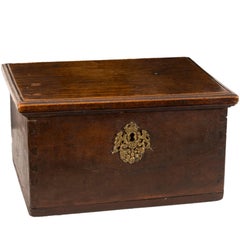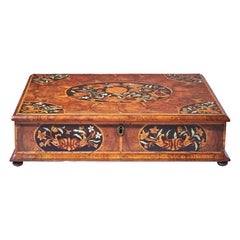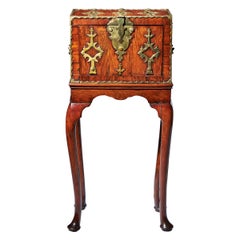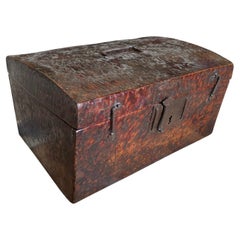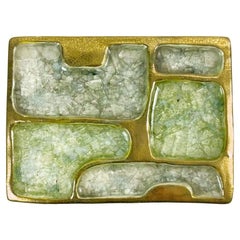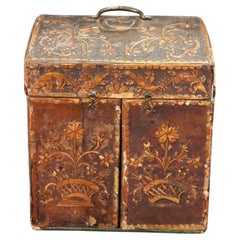17th Century Jewelry Boxes
16
to
12
4
16
16
16
2
55
495
1,024
428
285
345
251
54
34
65
50
26
47
89
104
43
20
Height
to
Width
to
14
5
5
4
4
11
5
4
4
2
Period: 17th Century
Walnut and Metal Small Chest, 17th Century
Located in Madrid, ES
Small rectangular ark with a flat lid, with a lock of golden metal worked (crown on two facing lions, located on a garland of great size, and all around a symmetrical composition wit...
Category
European Baroque Antique 17th Century Jewelry Boxes
Materials
Metal
17th Century William and Mary Floral Marquetry Olive Oyster Lace Box, Circa 1685
Located in Oxfordshire, United Kingdom
A fine and rare 17th-century William and Mary olive oyster floral marquetry lace box, circa 1685. England
The cross grain olive moulded and holly banded top is centred by an oval of...
Category
English William and Mary Antique 17th Century Jewelry Boxes
Materials
Bone, Boxwood, Ebony, Oak, Olive, Tulipwood, Holly
17th century colonial Sinhalese ebony two-door cabinet with silver mounts
Located in Amsterdam, NL
A splendid Dutch-colonial Sinhalese ebony two-door cabinet with silver mounts
Sri Lanka, Kandy, 2nd half 17th century, the mounts later
The cabinet with a central drawer with hidde...
Category
Sri Lankan Dutch Colonial Antique 17th Century Jewelry Boxes
Materials
Silver
Splendid Indo-Portuguese Colonial Sculpture of Nagini from Goa, 17th Century
Located in Amsterdam, NL
A fine Indo-Portuguese inlaid teak wood figure of Nagini
India, Goa, 17th century
Measure: H. 55 cm
(with stand, and with ring for wall hanging)
The sculpture can be perceived as such but probably is one of four legs of an Indo-Portuguese contador...
Category
Indian Antique 17th Century Jewelry Boxes
Materials
Ebony, Teak
17th Century William and Mary Rosewood Coffre Fort on Stand, Secret Compartments
Located in Oxfordshire, United Kingdom
The unique 17th-century William and Mary rosewood coffre forte, circa 1690, raised on George I walnut stand, circa 1720.
The rosewood veneered exterior...
Category
English William and Mary Antique 17th Century Jewelry Boxes
Materials
Brass
French 17th Century Leather Box, Coffre
Located in Atlanta, GA
A very charming late 17th century French Coffre - Box crafted from beautifully patina'd leather. A wonderful piece to serve as a jewelry box or to adorn any table top.
Category
French Antique 17th Century Jewelry Boxes
Materials
Leather
Antique Banner Box, in Period 1600s Walnut in Patina
Located in Cesena, FC
Banner box from the1600s of rectangular shape, resting on rounded feet.
The lower band is ornately carved and notched on three sides; on the front a fine modular motif. Splendid original and working antique lock...
Category
Italian Antique 17th Century Jewelry Boxes
Materials
Walnut
17th C. Diminutive William and Mary Kingwood Strongbox or Coffre Fort, C. 1690
Located in Oxfordshire, United Kingdom
A William and Mary Kingwood / Princes Oyster Strongbox or Coffre Fort of Diminutive Proportions, Circa 1680-1700, England.
Adorned with highly decorative gilt brass strapwork and decorated entirely in knife cut oysters of kingwood, this box is fit for the most discerning of collectors. The large gilt brass shield-shaped clasp opens on a push-spring release to reveal a box interior lined in rosewood with one drawer and securing bolts.
Once the lid is opened you can reach inside to slide the original gilt brass bolt lock to open the fall. Once the fall is open you will find a drawer lined in oak and simulated kingwood.
The box appears decorative, but it was also very difficult to break open or steal. It has a strong lock to the centre and two bolts concealed in the sides, so that it could be screwed down into floorboards if necessary or that of a horse-drawn carriage. Strong boxes veneered in oysters of Princewood such as this were luxury objects.
The cabinet-makers who would have constructed and veneered the carcase apparently sold them, often using tropical hardwood veneers, and mounted it with sets of mounts, handles and locks bought in from brass founders. The elaborate veneering and conspicuous gilded brass mounts show that the appearance of these objects was important.
Thomas Pistor, of Ludgate Hill, London worked with the renowned cabinetmaker Gerrit Jensen...
Category
British William and Mary Antique 17th Century Jewelry Boxes
Materials
Kingwood
Large William and Mary 17th Century Inlaid Olive Oyster Lace Box, Circa 1690
Located in Oxfordshire, United Kingdom
A fine and rare large parquetry inlaid 17th-century William and Mary period olive oyster lace box. 1680-1700, England
The cross-grain moulded top is ent...
Category
English William and Mary Antique 17th Century Jewelry Boxes
Materials
Oak, Olive, Ebony
Early 18th Century Black Japanned Trinket/Jewel Box
Located in Folkestone, GB
An exceptionally rare early 17th century, James I/Charles I, black Japanned jewel box decorated with gold and red flowers and foliage. With a domed lid, o...
Category
English Elizabethan Antique 17th Century Jewelry Boxes
Materials
Wood
Fine 17th Century and Later Floral Marquetry Box
Located in London, GB
A fine 17th century and later floral marquetry box with hinged lid.
Category
Antique 17th Century Jewelry Boxes
Materials
Wood
17th Century Spanish Burled Walnut Vargueno or Collectors Cabinet
Located in Milford, NH
A fine example of a diminutive burled walnut vargueno, collector or valuables cabinet, with molded cornice and drop front, opening to a multi-drawer ...
Category
Spanish Moorish Antique 17th Century Jewelry Boxes
Materials
Wrought Iron, Brass
Unique 17th Century Miniature Japanese Namban Lacquer Miniature Dollhouse Chest
Located in Amsterdam, NL
A unique and exceptional Japanese miniature or dollhouse export lacquered chest
Kyoto, circa 1620-1640
The chest of rectangular shape with a domed lid, decorated in Transition-style, in gold hiramaki-e on a black background within reserved lobed cartouches decorated with landscapes animated with birds and rabbits, on a shagreen or samegawa background. The borders are decorated with geometric friezes, the box with gilt-copper mounts, the interior decorated in red lacquer.
Measures: H 9.2 x W 14.5 x D 7.2 cm
This miniature is of exceptional quality and a perfect copy of the famous large size Transition-style coffers. It was most likely ordered by a Dutch lady for her dollhouse (poppenhuis), like the famous Petronella Oortman (1656-1716) doll-house, which is now one of the highlights in the collection of the Rijksmuseum Amsterdam, or Petronella Oortmans-de la Court’s (1624-1707) dollhouse in the collection of the Centraal Museum Utrecht. Sara Rothé of Amsterdam in 1743 ordered a miniature black lacquered ivory tripod table with gold chinoiserie decoration by Jurriaan Buttner (Monika Kopplin, European Lacquer, 2010, p. 56).
Other Japanned dollhouse...
Category
Japanese Edo Antique 17th Century Jewelry Boxes
Materials
Shagreen, Cypress
Fine Japanese Namban Lacquer Jewelry Casket, 17th Century
Located in Amsterdam, NL
Japanese Namban lacquer transition-style coffer with two drawers
Kyoto/Nagasaki, circa 1650
The cartouches with gilt and red decorations of leaves...
Category
Japanese Edo Antique 17th Century Jewelry Boxes
Materials
Cypress
Renaissance Revival Damacened and Bronze Casket
Located in Essex, MA
With a domed hinged lid and bail handle over a conforming case decorated overall with figures in Renaissance dress. Bun feet. Provenance; David and P...
Category
European Renaissance Revival Antique 17th Century Jewelry Boxes
Materials
Bronze
17th Century Franco Flemish Kingwood Marquetry Box
Located in Greenwich, CT
Fine 17th century domed box with highly figured kingwood marquetry veneer laid in a geometric pattern, the front having elaborate pierced and embossed brass escutcheon, the whole wit...
Category
European Baroque Antique 17th Century Jewelry Boxes
Materials
Kingwood, Pine
Related Items
Indian 19th Century Black Box with Iron Nailheads, Braces and Rustic Patina
Located in Yonkers, NY
An Indian antique black box from the 19th century with iron nailheads and braces, carved wooden base and rustic patina. Created in India during the 19th century, this box features a linear silhouette perfectly complimented by a black patina accented with iron nailheads. The lid opens fully to reveal a reddish brown lacquered interior with nicely weathered appearance. Raised on a carved wooden base with iron details, this antique Indian box...
Category
Indian Antique 17th Century Jewelry Boxes
Materials
Iron
17th Century English Leather Covered Knife Box Converted To a Letter Box
Located in San Francisco, CA
17th century leather knife box converted to a letter box with original brass hardware, sitting on brass ball feet.
Fitted interior lined with 18th century silk fabric.
In very good...
Category
European Antique 17th Century Jewelry Boxes
Materials
Brass
Japanese Tabako-bon with Two Rabbits, c. 1920
Located in Chicago, IL
This wooden box is a Japanese tabako-bon, or 'tobacco tray,' used to store tobacco and smoking accessories. Believed to have evolved from the traditional ...
Category
Japanese Taisho 17th Century Jewelry Boxes
Materials
Bamboo, Bakelite, Hardwood
Antique Indian Mughal Wood Dowry Chest with Carved Patterns, 19th Century
Located in Yonkers, NY
A 19th century Mughal dowry chest with carved patterns from India. This chest wooden chest with a slanted top strengthened by metal hardware reinforcements. The front displays lightly carved geometrical friezes. A large carved geometrical medallion adorns the triangular lid. The chest rests on four conical legs. This chest opens thanks to an door on the centre of its top. This unusual item was used as a dowry chest in India. This 19th century, Indian Mughal wood dowry chest...
Category
Indian Antique 17th Century Jewelry Boxes
Materials
Wood
17th Century Figured Walnut and Seaweed Marquetry Lace Box
Located in Oxfordshire, United Kingdom
A fine and extremely rare figured walnut and seaweed marquetry 'lace box', circa.... let’s break it down - Seaweed marquetry first appeared in Englis...
Category
English Baroque Antique 17th Century Jewelry Boxes
Materials
Walnut
19th Century Oak and Metal Bound Silver Chest
Located in Cheshire, GB
19th century oak and metal bound silver chest, applied with iron side swing handles and corner brackets, opening to an arrangement of four compartmentalised removable trays.
Dimensi...
Category
British Antique 17th Century Jewelry Boxes
Materials
Oak
Indian 19th Century Treasure Box with Brass Details and Partitioned Interior
Located in Yonkers, NY
An antique Indian handmade jewelry box from the 19th century with brass hardware, bracket feet and partitioned interior. Created in India during t...
Category
Indian Rustic Antique 17th Century Jewelry Boxes
Materials
Brass
H 7.5 in W 14.75 in D 9.75 in
Small Indian 19th Century Box with Brass Details and Compartmented Interior
Located in Yonkers, NY
A small Indian antique box from the 19th century, with brass details and compartmented interior. Created in India during the 19th century, this small wooden box...
Category
Indian Antique 17th Century Jewelry Boxes
Materials
Brass
H 7.5 in W 14.5 in D 9.75 in
Small 17th Century, French Coffer or Box in Leather
Located in Buisson, FR
Extremely old box that is covered with leather and metal decorations.
Rare find.
France, circa 1600-1700
Weathered and some losses.
Category
French Antique 17th Century Jewelry Boxes
Materials
Leather, Wood
English Regency Mahogany Travelling Lap Desk with Secret Compartment, on Stand
Located in Savannah, GA
This early 19th century lap desk is constructed of flame grain Honduras mahogany and features the original brass fittings and an embossed leather...
Category
English Regency Antique 17th Century Jewelry Boxes
Materials
Brass
H 25.75 in W 15 in D 10.5 in
17th Century English Jacobean Carved Oak Bible Box.
Located in Vero Beach, FL
17th Century English Jacobean Carved Oak Bible Box.
Period Jacobean solid dark oak bible box from the 17th century. The front is beautifully carved wi...
Category
English Jacobean Antique 17th Century Jewelry Boxes
Materials
Wrought Iron
Boiled Leather Trunk, Spanish, 17th Century
Located in Bruxelles, BE
Leather trunk
Spanish, 17th century
Boiled Leather, wood and iron
Measures: 22 x 53 x 32 cm.
Provenance :
- collection Metz-Noblat, Château de Clevant, France
Rectangular trunk of the form and size of a small suitcase with wrought iron hinges and lock-plate.
Wood, covered with leather, cut and embossed with every surface of the thick cow hide covered in interlace, zoomorphic features.
The construction method is boiled leather, often referred to by its French translation cuir-bouilli: a process used to change flexible, vegetable-tanned leather into rigid, moulded objects. For shaping of the vegetable-tanned leather, heat and moisture were used, as indicated by the term boiled leather. No written medieval sources describing the production of decorated cuir bouilli objects survive, so knowledge of the process relies on the important studies of the Scottish leather historian John William Waterer. A large range of methods, materials and techniques could be used in various combinations. The vegetable-tanned leather, made supple with moisture and heat, was stuffed, shaped and nailed to the rigid wooden coffer support. The stuffing material was probably modeled beeswax or stearin wax. To shape the leather, to create its topography, « Cushions » were made by lacing a thread through an awl hole and attaching the flexible leather and stuffing to the rigid wooden support on the bottom. Then the decoration was done: lines were incised through the upper layer of the leather (epidermis) with different thicknesses of knives or needles. Contours were created with deep v-shaped cuts, decoration with thin incision and final details with a needle point. For the incision and pouncing stage, the leather was probably kept heated and moistened for suppleness.
Once dry, the leather would be hard and rigid.
the saturated leather is worked over a form, possibly even damp sand, with the pattern shaped using bone or wooden tools. Compare to metal, leather was lighter and it offered protection from cuts and punctures. Cuir bouilli objects were produced by specialist leather workers and needed skillful craftsmanship.
The surface is filled with roundels shaped foliages enclosing animals, lions and peacocks. The foliate arabesques creating a vegetal connection tweet the animals create the impression of a lush verdant space . The vegetal pattern here employed in combination with geometrical pattern came from the pre-islamic artistic traditions of the Byzantine and Sasanian empires. An aspect of Islamic geometry Is the basic symmetrical repetition and mirroring of the shapes that create a sense of harmony.
The decoration of this truck is inspired by the islamic « arabesque » a form of vegetal ornament composed of spirals, intertwining plants and abstract curvilinear motifs. An arabesque character is given to the birds of the decorations through extreme stylisation. This arabesque maintained the classical tradition of median symmetry, freedom in Detail and heterogeneity of ornament.
The presence of the peacocks is a paradisiacal allusion: in popular Islamic literature they were among the original inhabitants of the garden of Paradise expelled with Adam and Eve. Peacock as a decorative motif may have originated in the West, despite their eastern provenance. There was an ancient belief that the flesh and feathers of peacock do not decay. This led to the peacock becoming a christian symbol for Christ’s resurrection.
Renowned for their decorative wall hangings, seventeenth-century Spanish leatherworkers also produced utilitarian objects, such as this trunk. A similar trunk is on display at the Metropolitan museum of art ( 09.158.1).
Related literature :
Davies L. 2006. Cuir bouilli. Conservation of leather and related materials, 94-102, Oxford: elsevier Butterworth-Heinemann
Grabar, Oleg. The Mediation of Ornament. Princeton: Princeton University Press, 1992
Gabriela Germana Roquez, "El mueble en el Peru en el siglo XVIII...
Category
Antique 17th Century Jewelry Boxes
Materials
Iron
Previously Available Items
French Ceramic Secret box or jewelry box or tidy - Mithé Espelt 60's Fance
By Mithé Espelt
Located in Beuzevillette, FR
Secret box, jewelry box, storage box, tidy rectangular with glazed ceramic lid in shades of gold, white and pellucid and wooden base, by Mithé Espelt.
The box is decorated with geome...
Category
French Antique 17th Century Jewelry Boxes
Materials
Ceramic
H 2.25 in W 5.71 in D 4.26 in
Rare Italian 18th Century Antique Jewelry Box in Papier-Mâché and Wood
Located in Casale Monferrato, IT
Beautiful and refined antique jewelery holder of Italian production from the mid-18th century. Of great artistic quality made on a papier-mâché base with an elaborate floral decorati...
Category
Italian Antique 17th Century Jewelry Boxes
Materials
Fruitwood
Important 17th Century Charles II Marquetry Olive Oyster Lace Box, Circa 1680
Located in Oxfordshire, United Kingdom
A fine and rare 17th century William and Mary olive oyster marquetry lace box, circa 1670-1690. England
Attributed to Gerrit Jensen.
The mould...
Category
English William and Mary Antique 17th Century Jewelry Boxes
Materials
Bone, Boxwood, Ebony, Oak, Olive, Tulipwood, Holly
H 5.52 in W 23.04 in D 17.33 in
1980s Mid-Century Modern Walnut Root, Maple and Brass Italian Jewelry Box
Located in Aci Castello, IT
A walnut, maple and brass rectangular box designed and manufactured in Italy in the Eighties. Brass it's in original patina, woods are in very good conditions. The box embodies the ...
Category
Italian Mid-Century Modern Antique 17th Century Jewelry Boxes
Materials
Brass
H 1.58 in W 9.45 in D 5.52 in
Late 17th Century Beautifully Inlaid Dutch Valuables Chest
Located in Milford, NH
A fine wooden valuables chest with decorative corner braces, a central foliate inlaid door, opening to three fitted drawers with leather pulls, flanked...
Category
Dutch Dutch Colonial Antique 17th Century Jewelry Boxes
Materials
Iron
Important 17th Century Charles II Burr Walnut Coffre Fort Strong Box, Circa 1675
By Gerrit Jensen
Located in Oxfordshire, United Kingdom
A rare and important 17th-century Charles II burr walnut coffre fort adorned in highly decorative gilt brass mounts and strapwork concealing six secret compartments.
Attributed to the Royal cabinetmaker, Gerrit Jensen...
Category
British Charles II Antique 17th Century Jewelry Boxes
Materials
Walnut, Burl
Free Shipping
H 12.8 in W 20.08 in D 15.36 in
18th Century William and Mary Olive Oyster Arabesque Marquetry Lace Box, C.1690
Located in Oxfordshire, United Kingdom
An extremely rare late 17th-century arabesque marquetry and olive oyster lace box of large scale, from the reign of William and Mary, circa 1690. England
The cross-banded ovolo-mo...
Category
English William and Mary Antique 17th Century Jewelry Boxes
Materials
Olive
H 5.52 in W 22.64 in D 17.72 in
17th Century William and Mary Kingwood Coffre Fort Box Concealing Three Secrets
Located in Oxfordshire, United Kingdom
A superb William and Mary Kingwood / Princes Oyster strongbox or coffre fort of small proportions, circa 1680-1700, England.
Adorned with highly decorative thick gilt brass strap...
Category
British William and Mary Antique 17th Century Jewelry Boxes
Materials
Oak, Kingwood
Free Shipping
H 8.27 in W 14.38 in D 9.26 in
17th Century William and Mary Floral Marquetry Olive Oyster Lace Box, circa 1680
Located in Oxfordshire, United Kingdom
A fine and rare 17th century William and Mary olive oyster marquetry lace box, circa 1670-1690. England
The ovolo-moulded and holly banded top is c...
Category
English William and Mary Antique 17th Century Jewelry Boxes
Materials
Bone, Oak, Boxwood, Olive, Ebony, Tulipwood, Holly
H 4.93 in W 21.26 in D 16.15 in
17th C. Diminutive William and Mary Kingwood Strongbox or Coffre Fort, C. 1690
Located in Oxfordshire, United Kingdom
A William and Mary Kingwood / Princes oyster strongbox or Coffre Fort, circa 1680-1700, England. Adorned with highly decorative gilt brass strapwork and decorated entirely in knife cut oysters of kingwood, this box is fit for the most discerning of collectors. The large gilt brass shield-shaped clasp opens on a push-spring release to reveal a box interior lined in rosewood with two drawers and securing bolts.
Once the lid is opened you can reach inside to slide the original gilt brass bolt lock to open the fall. Once the fall is open you will find two drawers lined in walnut divided by a secret compartment.
The box appears decorative, but it was also very difficult to break open or steal. It has a strong lock to the centre and two bolts concealed in the sides, so that it could be screwed down into floorboards if necessary or that of a horse-drawn carriage. Strong-boxes veneered in oysters of Princewood such as this were luxury objects.
The cabinet-makers who would have constructed and veneered the carcase apparently sold them, often using tropical hardwood veneers, and mounted it with sets of mounts, handles and locks bought in from brass founders. The elaborate veneering and conspicuous gilded brass mounts show that the appearance of these objects was important.
Thomas Pistor...
Category
European William and Mary Antique 17th Century Jewelry Boxes
Materials
Kingwood
H 8.27 in W 14.18 in D 9.45 in
17th C. Diminutive William and Mary Kingwood Strongbox or Coffre Fort, C. 1690.
Located in Oxfordshire, United Kingdom
A William and Mary Kingwood/Princes oyster strongbox or Coffre Fort, circa 1680-1700, England. Adorned with highly decorative gilt brass strapwork and decorated entirely in knife cut oysters of kingwood, this box is fit for the most discerning of collectors. The large gilt brass shield-shaped clasp opens on a push-spring release to reveal a box interior lined in rosewood with two drawers and securing bolts.
Once the lid is opened you can reach inside to slide the original gilt brass bolt lock to open the fall. Once the fall is open you will find two drawers lined in walnut divided by a secret compartment.
The box appears decorative, but it was also very difficult to break open or steal. It has a strong lock to the centre and two bolts concealed in the sides, so that it could be screwed down into floorboards if necessary or that of a horse-drawn carriage. Strong-boxes veneered in oysters of Princewood such as this were luxury objects.
The cabinet-makers who would have constructed and veneered the carcase apparently sold them, often using tropical hardwood veneers, and mounted it with sets of mounts, handles and locks bought in from brass founders. The elaborate veneering and conspicuous gilded brass mounts show that the appearance of these objects was important.
Thomas Pistor...
Category
European William and Mary Antique 17th Century Jewelry Boxes
Materials
Kingwood
H 8.27 in W 14.18 in D 9.45 in
17th Century Museum Grade William and Mary Olive Oyster Marquetry Lace Box
By Thomas Pistor
Located in Oxfordshire, United Kingdom
17th century Museum Grade William and Mary Olive Oyster Marquetry Lace box, C. 1670-1690. England
The ovolo-moulded and holly banded top is centred...
Category
English William and Mary Antique 17th Century Jewelry Boxes
Materials
Bone, Boxwood, Ebony, Olive, Holly
H 4.73 in W 21.26 in D 16.15 in
Recently Viewed
View AllMore Ways To Browse
Furniture Key Tassels
Mirrored Vanity Box
Antique Carved Wood Jewelry Box
Chinoiserie Jewellery
Vintage Wooden Jewellery Box Boxes
Vintage Wooden Jewelry Box
Walnut Jewelry Box
Wood Jewelry Box With Drawers
Jewelry Organizer
Antique Jewelry Showcase Furniture
Vintage Porcelain Jewelry Box
19th Century Jewelry Casket
85 Key
French Limoges Jewellery
18th Century French Jewelry Box
Antique Walnut Jewelry Box
Jewelry Box India
Antique Silver Plated Jewellery Box
